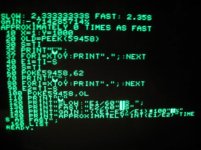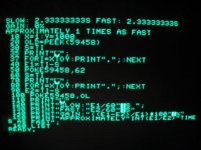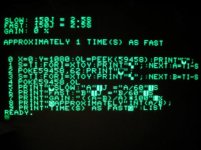JonB
Veteran Member
Hi all
I have just tried the KILLER POKE (POKE 59458,62) on my 3016 PET. It makes a huge difference to the performance of screen printing from BASIC and there is no snow whatsoever. Even when LISTing an entire program, I see no video artifacts.
Why would this be? If I'm writing to the screen RAM at the same time as it's being read by the video logic (or rather, altering it when not in the CRT's vertical retrace period), I would expect to see something..
The other question is, given that it's not a CRTC PET, is there any reason not to use it in my code?
Finally, what's the most commonly used technique for detecting a CRTC equipped PET? I'd like to put a safeguard round the KILLER POKE to prevent it being executed when running on a CRTC PET.
Incidentally, I read Andre Fachat's discussion of the killer poke but I didn't follow the finer points:
http://www.6502.org/users/andre/petindex/poke/index.html
Cheers
JonB
I have just tried the KILLER POKE (POKE 59458,62) on my 3016 PET. It makes a huge difference to the performance of screen printing from BASIC and there is no snow whatsoever. Even when LISTing an entire program, I see no video artifacts.
Why would this be? If I'm writing to the screen RAM at the same time as it's being read by the video logic (or rather, altering it when not in the CRT's vertical retrace period), I would expect to see something..
The other question is, given that it's not a CRTC PET, is there any reason not to use it in my code?
Finally, what's the most commonly used technique for detecting a CRTC equipped PET? I'd like to put a safeguard round the KILLER POKE to prevent it being executed when running on a CRTC PET.
Incidentally, I read Andre Fachat's discussion of the killer poke but I didn't follow the finer points:
http://www.6502.org/users/andre/petindex/poke/index.html
Cheers
JonB



